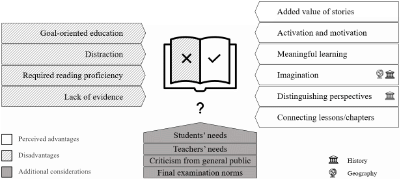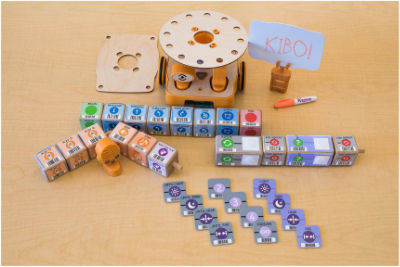Issue 15 – June 2022
Welcome to Educational Designer #15
This varied issue begins with a description by Marc North and Sarah Heesom of their large-scale project to promote sustained improvement in teaching quality in underperforming schools. They built the program around three agendas: a forensic analysis of needs and quality assurance; leadership development; and professional learning, underpinned by eight design principles. Clearly articulating the design principles enabled a high degree of coordination of the agendas and ensured all programme activities targetted priority areas.
Nina Sangers and colleagues Evers-Vermeul, Sanders and Hoeken report on the opinions and polices of Dutch educational publishers of biology, geography, and history textbooks. Focussing on the use of narrative and voice elements in text, they found little variation between target age groups, but differences between the three subjects. Many readers will also be interested in their insight into the publishers’ use of research findings.
Deborah Fields and six colleagues report on a virtual epidemic of SPIKEY-20 released into a virtual world, which infected thousands of players. SPIKEY-20 has many COVID-like features. The article links participant behaviour with strategic, tactical, and detailed design features of the virtual epidemic. It connects real-life and virtual public health behaviors and hence reveals something of the educative role that well-designed virtual epidemics could play in public health.
In the fourth article, Amanda Strawhacker, Emily Relkin and Marina Bers describe the development of an assessment for pre-schoolers of their skills in coding a child-friendly robot. They built the assessment around a previously established coding skills developmental framework. Trials of three modes of administration with diverse groups of pre-schoolers established that the short mode was best to assess these children.
As usual, I thank the editorial team, anonymous reviewers and Daniel Pead our design editor for the hard work that they put into each of the articles. The editorial team hopes this issue of journal will help us to spread ideas and good practice of educational design.
Kaye Stacey
14 May 2022
Making Every Person Count in Maths: A Framework of Professional Learning and Leadership Development for Whole-School Improvements in Mathematics

Read article
This position paper explores the design principles underpinning a large-scale professional learning and leadership development programme for staff in inner-city schools in Nottingham, England. The ‘Making Every Person Count in Maths’ framework embodied a design research process targeting sustainable improvements in the quality of mathematics teaching and attainment in a selection of underperforming inner-city primary and secondary schools by prioritising developments in leadership, teaching and in-class support, and children’s learning experiences. The framework is underpinned by eight design principles. These span three agendas which we believe are instrumental for sustainable school improvement in the identified priority areas: forensic analysis of needs and quality assurance; leadership development; and professional learning for teachers and other staff involved in the teaching and learning experience. We theorise the origins of the design principles and show how we used the principles to ensure a high degree of coordination of these agendas in the structure and contents of all programme activities to target the three priority areas. Our belief is that the high degree of coordination of these agendas and subsequent programme activities via the clearly articulated design principles made it more likely for involved schools to make sustained improvements in identified priority areas. Although subject Mathematics provided an initial context of application for this framework, we make the tentative claim that these design principles may transcend subject-specific boundaries to have application in a wide range of school-improvement activities.
North, M., Heesom, S. (2022)
Making Every Person Count in Maths: A Framework of Professional Learning and Leadership Development for Whole-School Improvements in Mathematics.
Educational Designer, 4(15).
Retrieved from:
http://educationaldesigner.org/ed/volume4/issue15/article57/
Why or when to include narrative and voice elements in educational texts?
Dutch publishers’ opinions and policies

Read article
This study presents the results of two focus group sessions and a group interview on the opinions and policies of Dutch educational publishers regarding the use of narrative and voice elements in educational texts for biology, geography, and history. This gives insight into the perceived advantages, disadvantages, and additional considerations publishers take into account during decision making concerning these elements. It appears that publishers’ motives for including narrative and voice elements are not influenced by educational level (primary vs. secondary education) but do depend on school subject (biology vs. geography vs. history). For instance, publishers strategically add narrative elements to history texts, in order to distinguish different historical perspectives and to stimulate students to imagine themselves in another time period. For biology and geography, however, publishers experience a tension between adding such elements and keeping the texts short and goal-oriented. In addition, publishers are torn between including narrative texts because these are favored by teachers and leaving them out because of a lack of convincing empirical effects on reading and learning outcomes.
Sangers, N.L., Evers-Vermeul, J., Sanders, T.J.M., Hoeken, H. (2022)
Why or when to include narrative and voice elements in educational texts? Dutch publishers’ opinions and policies.
Educational Designer, 4(15). ISSN 1759-1325
Retrieved from:
http://www.educationaldesigner.org/ed/volume4/issue15/article58/
Pandemics & People
Designing a Virtual Epidemic Event for Immersive, Connected, and Playful Participation in an Infectious Disease Outbreak

Read article
Researchers and educators have identified an urgent need for more rigorous teaching and learning about epidemiology topics and practices, such as engaging in behaviors that prevent the spread of viral disease such as COVID-19. Responding to this need, we designed a virtual epidemic as a special event hosted in a virtual world. In this paper we share the strategic, tactical, and detailed design of the SPIKEY-20 virtual epidemic and data that reflects back on the design in terms of player participation. Reflecting on the design, we ask: What kinds of players participated in the SPIKEY-20 virtual epidemic? How did players engage in designed activities (i.e., preventive measures, information seeking)? In what ways were players influenced by the concurrent real world pandemic of COVID-19? In the discussion we consider the potential connection points between real-life and virtual public health behaviors, new possibilities of classroom participation and teacher support for such a virtual event, and future design considerations for virtual epidemics.
Fields, D., Strawhacker, A., Giang, M., Kafai, Y., Tofel-Grehl, C., Hansen, T., Sun, J., Dinan, M. (2022)
Pandemics & People: Designing a Virtual Epidemic Event for Immersive, Connected, and Playful Participation in an Infectious Disease Outbreak.
Educational Designer, 4(15). ISSN 1759-1325
Retrieved from:
http://www.educationaldesigner.org/ed/volume4/issue15/article59/
Designing an Adaptive Assessment for Preschool Children’s Robotics Knowledge

Read article
Although Computer Science (CS) is gaining popularity in early education settings in the US and worldwide, there is a lack of agreement about how to assess learning in young children, particularly preschoolers. The current study presents the design and pilot of a developmentally appropriate assessment tool, the Coding Stages Assessment-KIBO (CSA-KIBO), to evaluate preschool children’s coding skills with a robot kit (KIBO) designed for young children. Using a design-based research framework we developed evidence-based design criteria to inform our iteratively-tested assessment tool. In this paper, we address the following research question: How does the mode of administration of the CSA-KIBO robotics assessment impact performance among preschool students? We administered CSA-KIBO to 151 coding naive preschool students ages 3-5 years, from ethnically, socioeconomically, and linguistically diverse backgrounds. Results showed that shorter administration formats were more suitable for our preschool sample and yielded similar assessment results to the lengthier format. Across all formats of administration, a possible floor effect was present in our coding-inexperienced sample. We consider the major contribution from this study to be a focused exploration of assessment administration as a critical aspect of assessment design for preschool-aged learners.
Strawhacker, A., Relkin, E., Bers, M.U. (2022)
Designing an Adaptive Assessment for Preschool Children’s Robotics Knowledge.
Educational Designer, 4(15). ISSN 1759-1325
Retrieved from:
http://www.educationaldesigner.org/ed/volume4/issue15/article60/